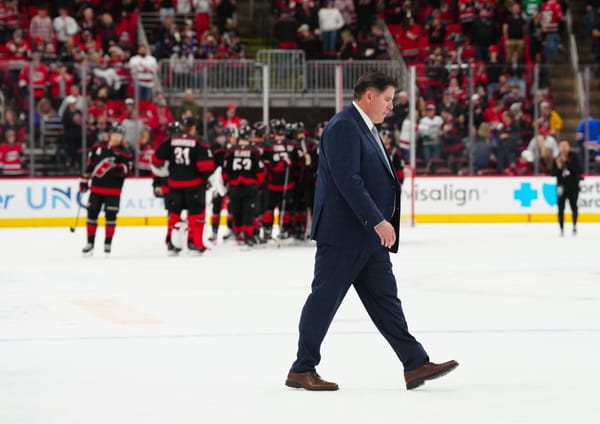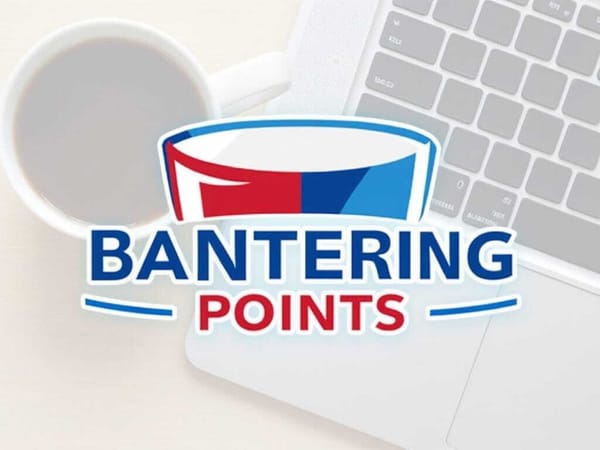Rangers’ Handling of Kravtsov, Andersson Highlights Need for Change of Approach
This is now two recent first-round picks the Rangers have managed to alienate.
The New York Rangers, after having spent several years working through a strong strategic rebuild plan, now find themselves at a bit of a crossroads.
While there were positive transactions and decisions related to the process, along with some luck, there were missteps along the way as well. There was James Dolan’s stunning firings of General Manager Jeff Gorton and Team President John Davidson earlier this year, which elevated Chris Drury from Associate General Manager to his current position of power as President and GM. That front office change cast some doubt on the continuity of the rebuild on which Gorton initially embarked.
On the player personnel side, there are now two cornerstone prospects from the Rangers’ rebuilding efforts who have expressed displeasure with the organization and how their development has been handled. Lias Andersson, the Rangers’ seventh overall pick in 2017, was traded to the Los Angeles Kings at the 2020 NHL draft, for the 60th overall pick (which became Will Cuylle). Now, Vitali Kravtsov, the ninth overall pick from 2018, appears to be headed down a similar path.
The Rangers may be eager to shift from rebuilding mode to playoff contention, but the broken relationships with these players signify cracks in the plan’s foundation, which should force the team to re-evaluate its process around player development.
The Roots of the Rebuild
In the immediate aftermath of the 2015-16 season, the Rangers began to move away from their prior status as a Stanley Cup contender after a smoke-and-mirrors 101-point season that culminated in a lopsided first-round loss to the Pittsburgh Penguins. Then-GM Gorton recognized a need for a shakeup, without yet being ready to commit to a full rebuild. That led to the offseason trade of popular and productive center Derick Brassard, and a seventh-round draft pick, to the Ottawa Senators for Mika Zibanejad and a second-round pick. That trade ended up being a steal for the Rangers, as they sold high on Brassard and bought low on the younger Zibanejad, who has since emerged as a star player.
The 2016-17 season was a minor step forward for the Blueshirts, but still featured some questionable underlying play, and eventually ended in a second-round playoff loss to the Ottawa Senators. It had the feeling of a series that the Rangers lost more so than the Senators won, and again highlighted the need for continued change.
That ensuing offseason was another key milestone, as it was the first explicit acknowledgement from Gorton and co. that the Rangers were looking to rebuild—albeit, “on the fly.” At the draft, the club traded another popular and productive center, Derek Stepan, to the Arizona Coyotes. Also included in the trade was backup goalie Antti Raanta. In return, the Rangers received a talented defenseman with quite a bit of baggage in Tony DeAngelo, and the seventh overall pick in that day’s draft.
That seventh overall pick would become Lias Andersson—the first of the two prospect relationships that have recently gone sour for the organization.
The Andersson and Kravtsov Situations
Andersson’s standing as a cornerstone prospect for the Rangers only took a couple of years to culminate in a trade request in December of 2019. A number of factors led to that (for a deeper dive from the time of the request, click here). It was fair at that time to question how the Rangers handled the situation. But it was just as fair to give the organization some benefit of the doubt for this situation in particular, as this type of thing had not yet become a pattern. Maybe Andersson had some character issues and was not doing enough to fulfill his potential.
That being said, even if the latter scenario was a closer reflection of reality, then that still raises concerns about the Rangers’ ability to evaluate prospects. Andersson was lauded for having a high floor as a player and excellent character and leadership qualities. The situation that unfolded with him underscored that he did not deliver on any of those traits. So either the Rangers mishandled the relationship with him, or they did not evaluate him properly ahead of drafting him. Or, it was a little bit of both.
At the end of the day, a top-10 draft choice and key prospect in the Rangers’ early rebuilding efforts was eventually shipped out on a discount. That was a major hit to the team’s efforts to retool—especially given its need for center depth. Between this and the Rangers’ jettisoning of DeAngelo last year because of—yes, character issues—the team got a pretty poor return for Stepan and Raanta.
The Andersson saga makes the present situation with Kravstov look even worse, and the situations together make it much more difficult to give the organization any benefit of the doubt. The Rangers took Kravtsov with the ninth overall pick in the 2018 draft, even though other highly-rated prospects like Oliver Wahlstrom were there for the taking, because of his potentially dynamic skill set. This was the club’s first draft selection since Gorton and the brass went all-in on a full rebuild with the famous letter from February of 2018, but it’s questionable whether the club truly invested in Kravtsov’s skill set since that draft.
Only a year after cutting ties with a recent top-10 draft pick in Andersson, the Rangers appear to be on the verge of doing so yet again with Kravtsov. Based on a report from The Athletic’s Arthur Staple, the Rangers’ relationship with Kravtsov appears to be past the point of repair. Multiple demotions to AHL Hartford, and contentious confrontations with Drury (which reportedly included Drury dressing down Kravtsov in front of his teammates in the 2020 Toronto bubble, criticizing the young Russian for not working hard enough), are the high-level factors that got the Rangers and Kravtsov to this point.
Once again, both the player and the organization come out of this mess shouldering some of the blame. But the common denominator here is Drury (who was Hartford’s GM during the Andersson developments) and the Rangers, and an apparent inability on their part to tailor their player development and relationship building processes to each individual player’s needs.
The Rangers Need to Learn From These Failures
The Rangers first acknowledged the term “rebuild” in 2017. Since then, some good things have certainly happened, including lucky draft lottery wins that led to the drafting of Kaapo Kakko and Alexis Lafrenière, as well as selections of K’Andre Miller, Nils Lundkvist, Filip Chytil, Zac Jones, and Braden Schneider, among others. They also landed a superstar in Artemiy Panarin, and acquired Adam Fox after he essentially forced his way out of Carolina.
Now, however, the rebuild looks to be hamstrung by the departure of one recent lottery pick and the impending departure of another. For a team in the midst of a rebuild, losing one lottery pick is bad enough. Losing two represents a serious problem that needs to be addressed on a more macro level.
Accumulating a plethora of assets is only one component of a rebuild. Another vital one is player development. While there were questions around Andersson and Kravtsov being the right picks for the Rangers at the time they were drafted, they were nevertheless promising prospects with quite a bit of potential. They needed to be nurtured and developed the right way. There is not a one-size-fits-all approach to player development, as players are human beings—which Drury acknowledged just last year. And not all draft picks, even those selected as high as the first round, become impact NHLers, or NHL players at all. But the onus is on the organization drafting the player to cater to a prospect’s needs to the best degree possible to help them succeed. Some players thrive in a more laid-back environment, where they are given latitude to fail and try again. Others are motivated by tough love.
With the more recent Kravtsov debacle, it seems that Drury’s confrontational approach did not have the desired effect. It only made the player more disgruntled. The fact that Drury and the Rangers did not recognize this after the initial tumult that followed Kravtsov’s first AHL demotion a couple years ago is worrisome. The efficacy of the communication from Drury and the Rangers comes into question. Demoting Kravtsov after sending signals that he’d be on the NHL roster (e.g., Kravtsov’s 20-game NHL stint at the end of last season, the offseason trade of right wing Pavel Buchnevich that freed up a lineup spot at his position of right wing, and Drury opting to have Kravtsov participate in voluntary workouts with the NHL regulars in lieu of this year’s prospect development camp) understandably stoked the ire of the 21-year-old.
With all of this in mind, one can still find blame on the player’s side. I.e., his conditioning might not have been up to par, his work ethic might have left a lot to be desired, etc. But even then, it’s still incumbent on the Rangers to A) do their homework ahead of making a draft choice like this, B) tailor their communication and development efforts to the needs of this player, and C) exhaust all possibilities for steering their promising young prospect back on track when there are signs of trouble, instead of adding fuel to the fire and further damaging the relationship.
More tactically, the Rangers need to revisit their staffing setup with respect to player development and European scouting. Maybe it’s just a coincidence that these untenable situations unfolded with two European players. But regardless of that being a factor or not, it’s important to have people in the organization who can effectively communicate with and develop foreign players. The Rangers fired their director of European scouting, Nick Bobrov, this past summer. Whether or not that had anything to do with the Andersson situation, or if it was just more house cleanup following the dismissals of Gorton and Davidson, the Rangers now need to make sure that part of the organization is shored up.
There needs to be a robust support system in place for players to ensure their positive development, and for players of all backgrounds at that. That is of the utmost importance for any team, let alone one trying to successfully rebuild.
At a minimum, a team in the Rangers’ situation needs to be giving its prospects every chance to grow and succeed — not fracturing relationships with them and then losing them for a fraction of their original draft value.





